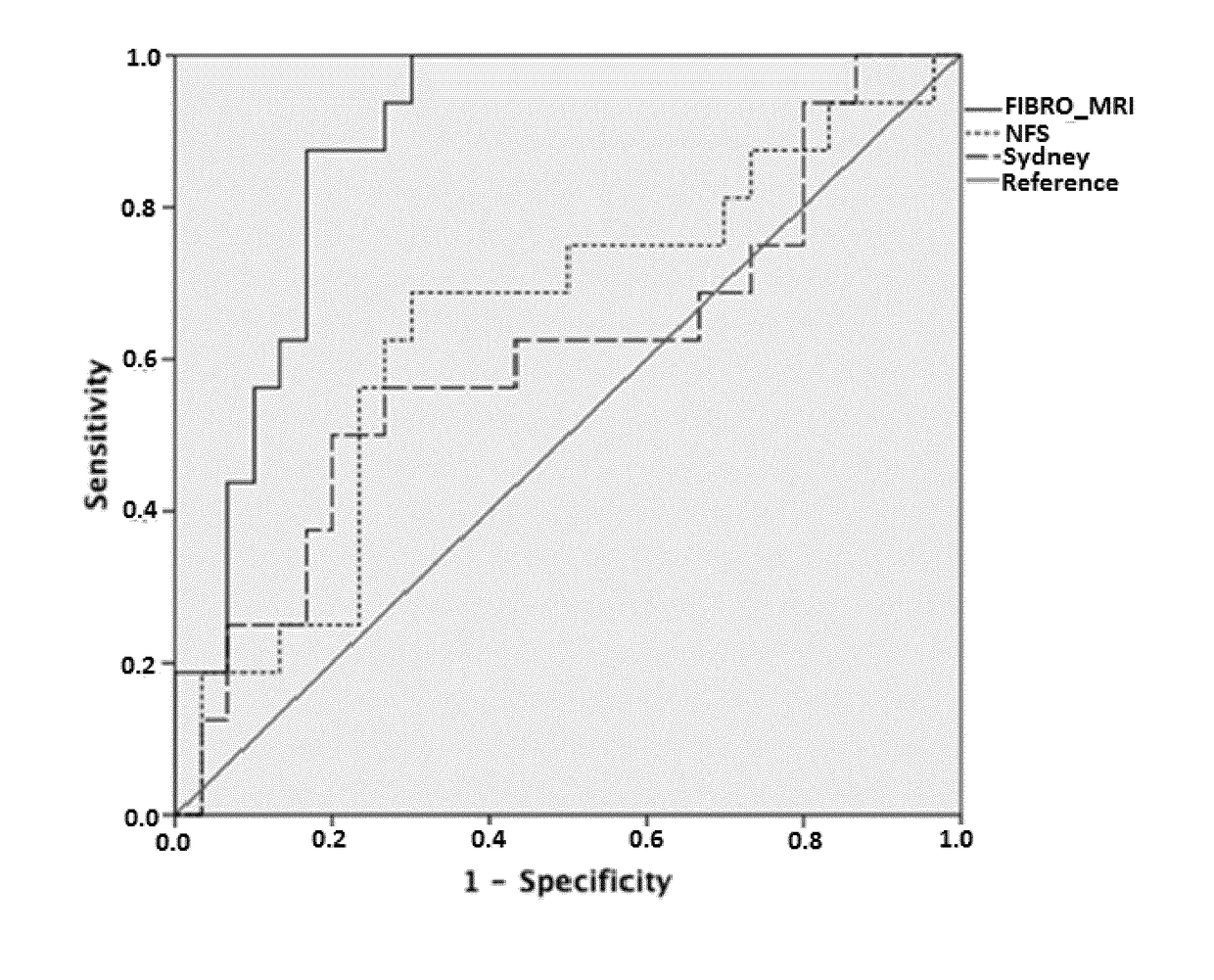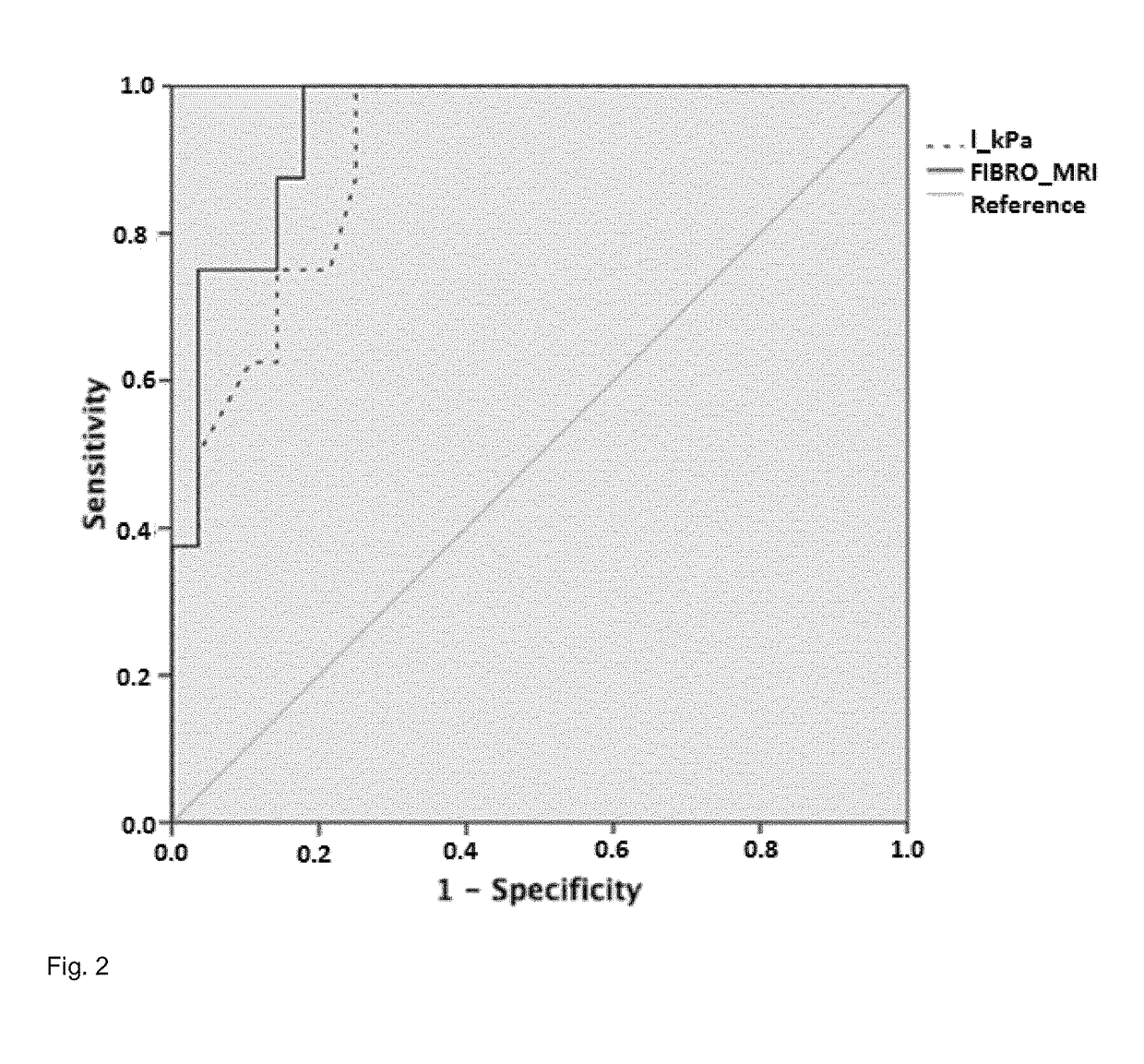Computerized optical analysis methods of mr (magnetic resonance) images for quantifying or determining liver lesions
a technology of computerized optical analysis and magnetic resonance, applied in the field of hepatic diagnosis, can solve the problems of insufficient sensitiveness and often inaccurate, and the performance of this kind of test may be insufficient, so as to monitor the potential therapeutic
- Summary
- Abstract
- Description
- Claims
- Application Information
AI Technical Summary
Benefits of technology
Problems solved by technology
Method used
Image
Examples
example 1
nt and Standardization of NASH-MRI for Detection of Steatohepatitis
[0154]Estimator E3 (harmonic mean) from MRI protocol SSFSE-T2, estimator E57 (2-2 order contrast) from MRI protocol DYNAMIC, and estimator E73 (weighted mean curvature) from MRI protocol FAST-STIR, were found to be independently associated with NASH.
[0155]Model coefficients associated with each one of these independent variables were β1=0.079 (OR: 1.08, 95% CI: 1.02-1.15; p=0.015) and β2=0.22 (OR: 1.14, 95% CI: 1.03-1.26; p=0.015).
[0156]These estimators influence on the predictive equation to obtain the probability of suffering steatohepatitis:
NASH-MRI=1 / (1e(1.654−0.079*E3_T2−0.127*E57_DYN*E73_FAST))
[0157]AUROC obtained was 0.88 (95% CI: 0.77-0.99) in the estimation cohort. Values for sensitivity of 87%, specificity of 74%, positive predictive value (PPV) of 80% and negative predictive value (NPV) of 82% were obtained from prediction based on a cut-off point of 0.5 for NASHMRI.
[0158]In the validation cohort, NASH-MRI...
example 2
nt and Standardization of Fibro-MRI for Detection of Fibrosis
[0159]Estimator E22 (Pearson's asymmetry coefficient) from MRI protocol SSFSE-T2 and estimators E3 (harmonic mean), E6 (mode), E31 (column's mean of multi-oriented co-occurrence matrix) and E75 (maximum of main curvatures) from MRI protocol DYNAMIC were found to be independently associated with fibrosis. Model coefficients associated with each of these independent variables were: β1=1.101 (OR: 3.01, 95% CI: 1.25-7.25; p=0.014); β2=−1.105 (OR: 0.33, 95% CI: 0.14-0.77; p=0.010); β3=−115.737 (OR: 0.08, 95% CI: 0.02-0.14; p=0.046) β4=0.696 (OR: 2.00, 95% CI: 1.19-3.38; p=0.009); and β5=−0.825 (OR: 0.44,v95CI %: 0.21-0.93; p=0.030) should be introduced into the predictive equation to obtain the risk of suffering fibrosis as:
Fibro-MRI=1 / (1+e(−4.207-1.101*E3_DYN+1.105*E6_DYN+115.737*E22_T2−0.696*E31_DYN+0.825*E75_DYN))
[0160]In the estimation cohort, AUROC was 0.94 (95% CI: 0.87-1.00) with a sensitivity of 81%, specificity of 85%,...
example 3
zation of NASH-MRI and Fibro-MRI Across MRI Systems
[0162]NASHMRI, calculated using a GE scanner, showed a similar diagnostic accuracy AUROC=0.76 (95% CI: 0.58-0.96) vs. AUROC=0.83 (95% CI: 0.70-0.96); p=ns in comparison with NASHMRI calculated in patients that underwent MRI with the Philips system. With respect to FibroMRI, evaluations performed using a GE scanner showed an AUROC=0.81 (95% CI: 0.66-0.95) vs. AUROC=0.86 (95% CI: 0.72-0.99) using the Philips system (p=ns).
[0163]Comparative analysis with non-invasive biochemical markers of steatohepatitis NASHMRI was compared with FGF-21 and CK-18 in the diagnosis of steatohepatitis in a cohort of 64 patients. NASHMRI offered the best diagnostic accuracy with an AUROC of 0.86 (95% CI: 0.76-0.96) for steatohepatitis presence significantly better than CK-18 levels AUROC of 0.56 (95% CI: 0.40-0.71; p<0.05) (FIG. 1). NAS score correlated with both NASH-MRI (r=0.38; p<0.001) and CK-18 levels (r=0.29; p<0.02).
[0164]Comparative analysis with ...
PUM
 Login to View More
Login to View More Abstract
Description
Claims
Application Information
 Login to View More
Login to View More - R&D
- Intellectual Property
- Life Sciences
- Materials
- Tech Scout
- Unparalleled Data Quality
- Higher Quality Content
- 60% Fewer Hallucinations
Browse by: Latest US Patents, China's latest patents, Technical Efficacy Thesaurus, Application Domain, Technology Topic, Popular Technical Reports.
© 2025 PatSnap. All rights reserved.Legal|Privacy policy|Modern Slavery Act Transparency Statement|Sitemap|About US| Contact US: help@patsnap.com



